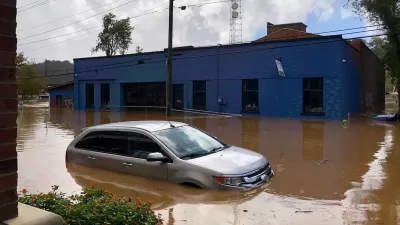This month's deluge resulted in damage or total destruction of "an estimated 200 miles of state highways and 50 bridges" in over 12 counties, estimated to cost $475 million. Contracts have been awarded for "initial work to be completed by Dec. 1".
Donna Bryson writes that before homeowners and businesses can rebuild within the 1,500 square-mile region scarred by the flooding, roads and bridges must be repaired or reconstructed in order to get the materials to them. Moreover, the region's economy is greatly dependent on tourism.
Brooke Burnham, a spokeswoman for the Estes Park tourism development agency, said 50% of the jobs in Estes Park, in Larimer County, are directly or indirectly dependent on tourism. "It's really damaging to us when the word gets out that we're cut off, or a ghost town. We really need guests to make sure our businesses and our workers survive the winter", she said.
That is the goal of Don Hunt, executive director of the Colorado Department of Transportation, as well as the governor (see below). He "said his department has a $100 million contingency fund, and expects to spend all of it repairing flood damage. Mr. Hunt's department has begun awarding contracts for initial work to be completed by Dec. 1.
Additional financial help is expected to come "from the Federal Highway Administration's Emergency Relief program, under which Congress has made available $1 billion for repairs from natural disasters nationwide", Bryson wrote. However, a check of the actual program indicates that "$100 million is authorized annually for the ER Program under 23 U.S.C. 125" although "MAP-21 eliminated the $100 million per State event cap."
In addition, the federal funds require matching funds. Presumably that would come from CDOT's $100 million contingency fund.
Approved ER funds are available at the pro-rata share that would normally apply to the Federal-aid facility damaged. For Interstate highways, the Federal share is 90 percent. For all other highways, the Federal share is 80 percent.
Colorado Gov. John Hickenlooper calls the "Flood recovery now a race against winter", writes Matt Pearce in the Los Angeles Times. In what may be an unusual move, he has appointed a business executive from the consulting firm, IHS Inc., in charge of the recovery "which he framed as "a race against the onset of winter."
Jerre Stead, the executive chairman of IHS Inc., a global information company, will become the state's so-called Chief Recovery Officer as Colorado contends with roughly 2,000 lost homes, 200 miles of destroyed state highways and scores of bridges damaged or destroyed across the state.
Eight fatalities resulted from the mid-September floods as did numerous oil and raw sewage spills. Photos of the historic flooding are available courtesy of The Atlantic's In Focus.
FULL STORY: Broken Roads a Big Hurdle in Colorado Flood Recovery

Planetizen Federal Action Tracker
A weekly monitor of how Trump’s orders and actions are impacting planners and planning in America.

Maui's Vacation Rental Debate Turns Ugly
Verbal attacks, misinformation campaigns and fistfights plague a high-stakes debate to convert thousands of vacation rentals into long-term housing.

San Francisco Suspends Traffic Calming Amidst Record Deaths
Citing “a challenging fiscal landscape,” the city will cease the program on the heels of 42 traffic deaths, including 24 pedestrians.

Amtrak Rolls Out New Orleans to Alabama “Mardi Gras” Train
The new service will operate morning and evening departures between Mobile and New Orleans.

The Subversive Car-Free Guide to Trump's Great American Road Trip
Car-free ways to access Chicagoland’s best tourist attractions.

San Antonio and Austin are Fusing Into one Massive Megaregion
The region spanning the two central Texas cities is growing fast, posing challenges for local infrastructure and water supplies.
Urban Design for Planners 1: Software Tools
This six-course series explores essential urban design concepts using open source software and equips planners with the tools they need to participate fully in the urban design process.
Planning for Universal Design
Learn the tools for implementing Universal Design in planning regulations.
Heyer Gruel & Associates PA
JM Goldson LLC
Custer County Colorado
City of Camden Redevelopment Agency
City of Astoria
Transportation Research & Education Center (TREC) at Portland State University
Jefferson Parish Government
Camden Redevelopment Agency
City of Claremont





























